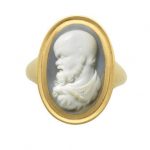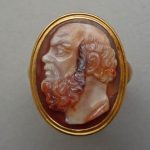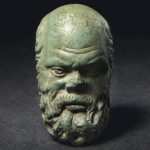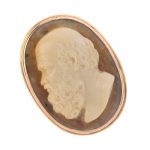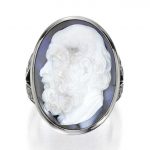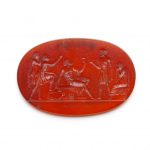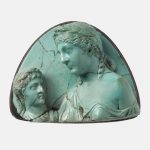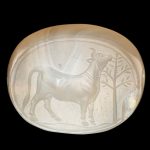Information on Socrates and Socrates cameos. Socrates, 470/69-399 BC, is credited as the father of modern Western philosophy. He was an Athenian citizen who devoted his life to philosophy but because he did not write anything, he is also an elusive historical figure. What we know about his life, his conversations, his beliefs (virtue in knowledge, self-awareness, etc), even his satyr-like looks, is from the subjective writings of his pupils Plato and Xenophon and the dramatist Aristophanes. Surviving classical portraits were probably rendered after his death. His image was worn by his followers and was later a popular subject in Roman, Renaissance and neo-Classical cameos whereby the wearer demonstrated his taste and refinement by his knowledge of ancient Greek culture. Reference: Bonhams
His method of enquiry was to enter into a penetrating discussion with his companions, questioning the nature of knowledge itself in pursuit of absolute truths. Socrates himself wrote nothing, but versions of his conversations are recorded in the written works of his pupils Plato and Xenophon. Socrates’ pursuit of true knowledge brought him into conflict with the piety laws of his native Athens, where his eventual prosecution led to enforced suicide by drinking hemlock. Reference: The British Museum
An agate cameo of Socrates, probably Roman Oval, in profile facing left, against a blue-grey ground, within a later gold mount, ring size N, length 16mm, width 10mm
Sold for £ 2,750 inc. premium at Bonhams in 2014
18th century cameo; onyx; head of Socrates to left.
© The Trustees of the British Museum
A ROMAN MINIATURE GREEN STONE PORTRAIT HEAD OF SOCRATES CIRCA 1ST CENTURY A.D. His bald pate with thick wavy hair low at the sides and back of his head, his forehead creased, with articulated eyes, a broad nose and a full beard, his moustache framing thick lips 1¼ in. (3.2 cm.) high
Sold for GBP 5,250 at Christies in 2012
An agate cameo ring. The oval agate carved to depict Socrates in profile, with grooved band. Ring size Q. Weight 11.1gms. CONDITION Overall condition good. Some surface scratches/wear in keeping with general age and wear. Cameo in good condition, with minor scratches to the surface.
Sold for £580 at Fellows in 2017
Agate and Colored Diamond Ring, Hemmerle The agate cameo featuring the profile of Socrates, bezel-set within a shank accented throughout with round diamonds of orangy brown hue, size 6¼, with maker’s mark, one diamond missing.
Sold for 13,750 USD at Sothebys in 2018
Horizontal oval intaglio. Red translucent carnelian. Depicting Socrates, bearded and partly bald, naked except for a loose draped garment sitting on a low platform to which shackles are attached, facing left in profile and raising a drinking vessel up in his left hand. Four other draped male figures, two to left and two to right, stand and sit around him, the two outer figures weeping, those nearest to Socrates gesturing. Circa 1820-30
This gem is in the neo-classical style popular in the late 1700s and early 1800s, when taste in the arts echoed the subject matter and style of the Greek and Roman masters. Thousands of gems were made in this style in Italy and brought back by British Grand Tourists, who went there to visit the newly-discovered classical antiquities and archaeological sites. It once belonged to the collection of Prince Stanislas Poniatowski (1754-1833), a wealthy collector who commissioned about 2500 engraved gems and encouraged the belief that they were ancient. Many even bore the signatures of the most celebrated Greek and Roman engravers. The collection was sold in 1839 following Poniatowski’s death, and later the scandal of its true background emerged and many gems subsequently changed hands for very low prices and were widely dispersed. The Poniatowski affair is often credited with causing a loss of confidence in the market for engraved gems, and the subsequent decline in the art from the mid nineteenth century onwards. Nowadays, ironically, the Poniatowski collection is of increasing interest as most of the gems were the work of a small group of neo-classical gem-engravers in Rome, including most probably the great Luigi Pichler (1773-1854),and have come to be regarded as important works of gem-engraving. The engravers of the Poniatowski gems took their subjects from Classical literature, especially the works of Homer, Virgil and Ovid. Here the engraver depicts the famous scene of Socrates taking his own life (399 BC), surrounded by his disciples. The philosopher had been tried in Athens for corrupting youth and denying the existence of the ancestral gods. He was offered exile and the renunciation of his teaching life, or death by poisoning. He chose to drink hemlock and die – ‘the unexamined life is not worth living’ – and the scene at his death was described by his pupil Plato. Back to search results Next Print this record Help with searching About the database Browsing Searching Viewing your results Presenting your results Narrowing your results Sorting your results Individual object records Your account Registration and login Edit account Recent order history Using images Non Commercial Use Commercial use Guide to downloading Frequently asked questions Technical API terms API getting started Crowdsourcing Test search by colour Search the Archives About Us Contact Us FuturePlan National Art Library Copyright: © Victoria and Albert Museum, London 2017. All Rights Reserved We use cookies to enhance your experience on V&A websites. Read our cookie policy to find out more.
Reference: © Victoria and Albert Museum
